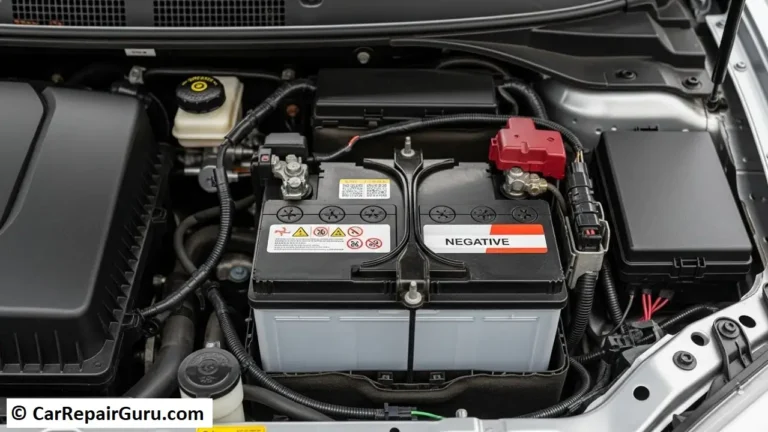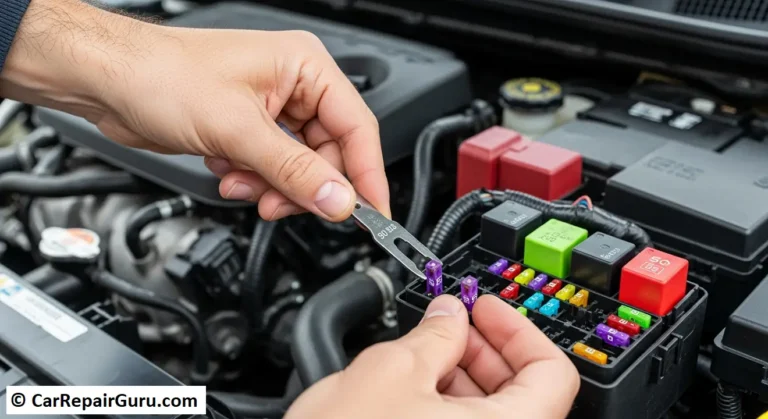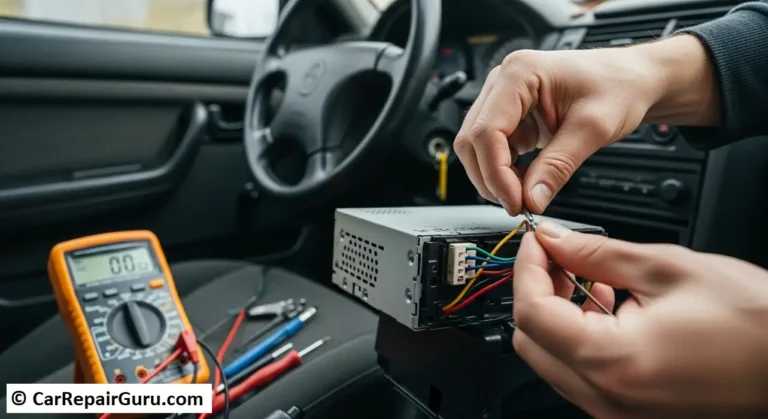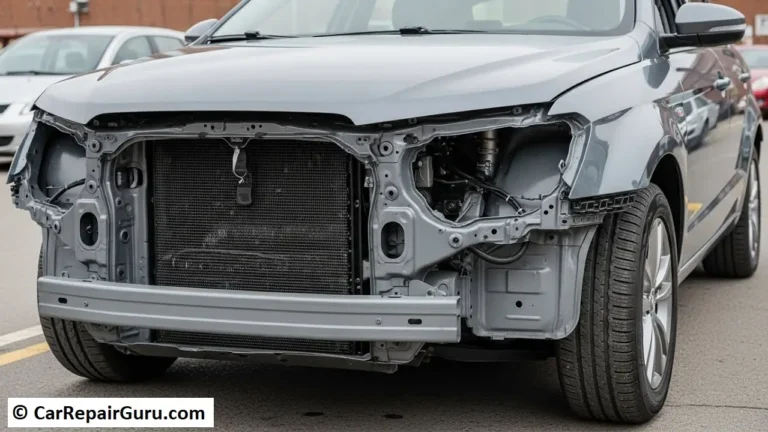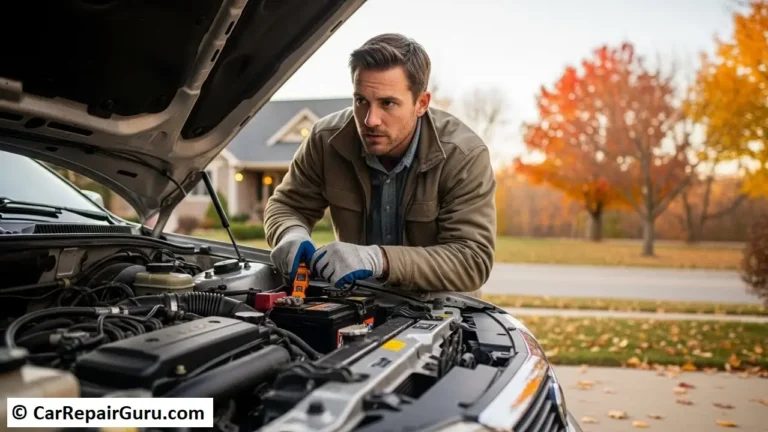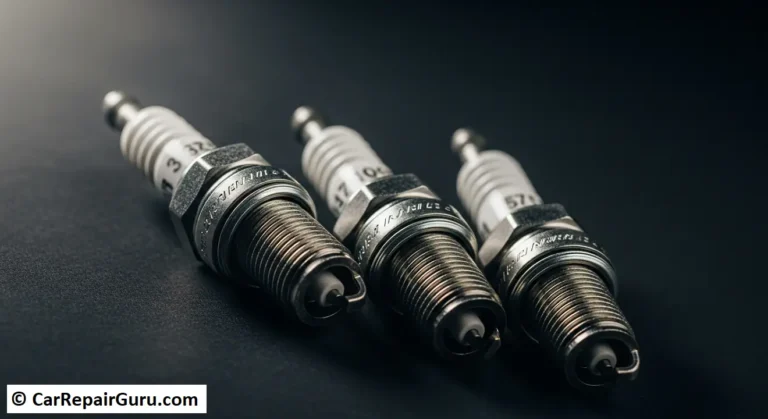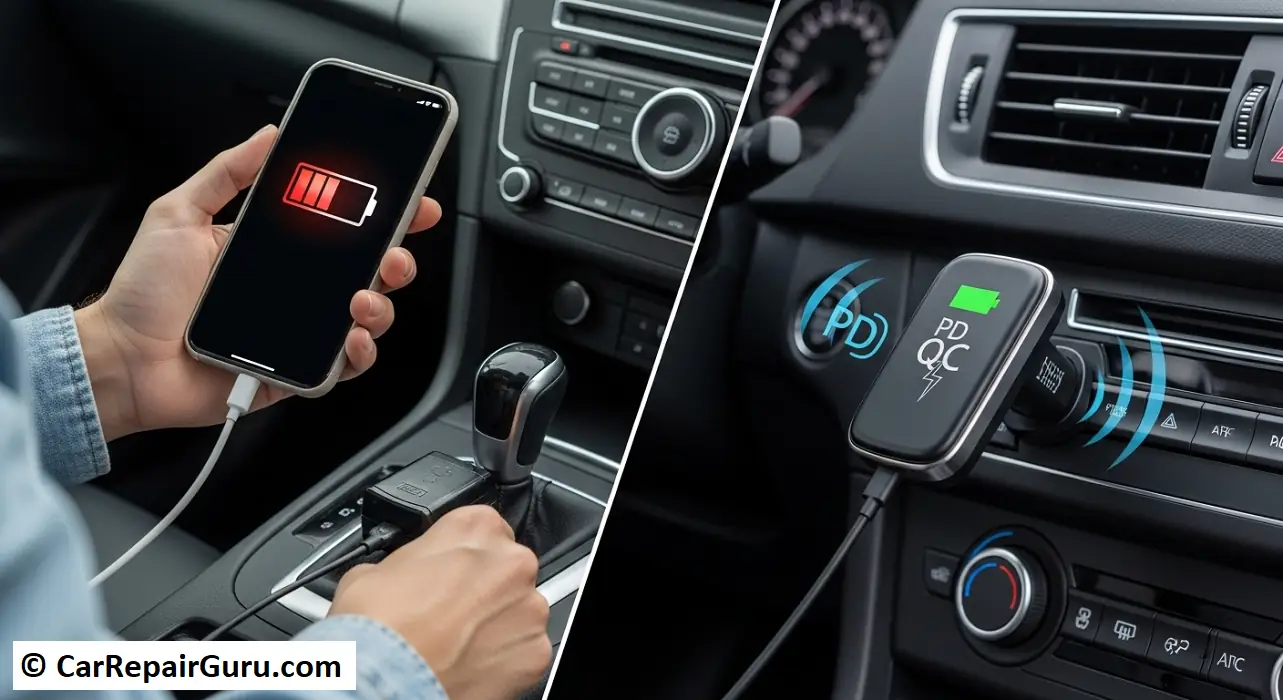
Let’s be honest—that blinking red battery icon on your phone is a universal symbol of modern-day panic. It always seems to appear at the worst possible moment: when you’re navigating to a new place, about to receive an important call, or just trying to stream a podcast to survive your commute. You reach for your car charger, plug it in, and… nothing. Or worse, you watch the battery percentage creep up a single point over a 20-minute drive.
This is the frustrating reality of using a cheap, underpowered, or outdated car phone charger. In a world where our devices are our lifelines, a reliable power source in your vehicle isn’t a luxury; it’s an absolute necessity.
But finding the best car charger can feel like a chore. The packaging is a confusing alphabet soup of terms like “PD,” “QC,” “Watts,” and “Amps.” Don’t worry. This guide will cut through the noise. We’re here to help you understand what actually matters, so you can choose a car charger that powers up your devices quickly, safely, and efficiently, keeping you connected wherever the road takes you.
Decoding the Tech: Key Terms You Need to Know
Before you can pick the perfect charger, you need to speak the language. Understanding these few key terms will transform you from a confused buyer into an informed expert, ensuring you get a product that actually meets your needs.
Watts (W): The Measure of Power
Think of watts as the raw horsepower of a charger. It’s the simplest and most important number to look at. The higher the wattage, the more power the charger can deliver to your device, which generally translates to a faster charge. An old charger might only offer 5W, which is painfully slow for today’s phones. A modern fast car charger will typically start at 20W and can go much higher. This is the first spec you should check when wondering how many watts for a car charger you really need.
Power Delivery (PD): The Gold Standard for Fast Charging
If you see “Power Delivery” or “PD” on the box, pay attention. This is a smart charging technology that uses a USB-C car charger port to negotiate the fastest possible charge your device can safely handle. It’s the universal standard for fast charging modern devices, including every new iPhone, Google Pixel, and Samsung Galaxy phone. If you want to take your phone from 0% to 50% in around 30 minutes, you need a charger with PD. This is the definitive answer to what is PD charging.
Qualcomm Quick Charge (QC): The Android Alternative
Qualcomm Quick Charge, or “QC,” is another popular fast-charging technology, primarily found in Android phones with Qualcomm Snapdragon processors. While Power Delivery is becoming the universal standard, many great chargers support both PD and QC. This makes them incredibly versatile, able to fast-charge nearly any device you or your passengers might have.
Volts (V) and Amps (A)
You don’t need to be an electrician, but a simple analogy helps. If electricity were water flowing through a hose:
- Volts (V) would be the water pressure.
- Amps (A) would be the width of the hose (how much water can flow at once).
- Watts (W) is the total amount of water coming out. (Watts = Volts x Amps).
All you really need to remember is that a charger needs both high voltage and high amperage to deliver high wattage for a truly fast charge.
Types of Car Chargers: Finding Your Perfect Match
Car chargers are no longer one-size-fits-all. They come in various shapes and sizes, each designed for a different type of user. Let’s break down the most common types to help you find your ideal match.
The Classic: USB-A Chargers
This is the charger everyone recognizes—the one with the rectangular port that’s been around for years. While still useful for older accessories or basic charging, they lack the speed and intelligence of modern standards.
- Pros: Often very cheap, compatible with all your old cables.
- Cons: Cannot support the fastest charging speeds (like PD), quickly becoming obsolete.
The Modern Powerhouse: USB-C (PD) Chargers
Featuring the small, oval-shaped USB-C port, these are the champions of speed. A dedicated USB-C car charger is the best choice for anyone with a smartphone from the last few years. It’s the only way to unlock the true potential of Power Delivery fast charging. This is the go-to option for an iPhone car charger or a flagship Android device.
- Pros: Blazing-fast charging speeds, future-proof technology, universally compatible with new devices.
- Cons: Requires a USB-C to USB-C or USB-C to Lightning cable.
The Best of Both Worlds: Multi-Port Chargers
Why choose when you can have it all? A car charger with multiple ports, often combining one USB-C and one or more USB-A ports, is the ultimate crowd-pleaser. It allows you to fast-charge your new phone while a passenger charges their older device or a wireless earbud case. They are perfect for families, carpools, and road trips.
- Pros: Incredibly versatile, can charge multiple devices simultaneously, great value.
- Cons: Total power is often split between ports, so charging two power-hungry devices may slow them both down.
The Cable-Free Convenience: Wireless Charging Mounts (Qi & MagSafe)
Tired of fumbling with cables? A wireless car charger combines a phone mount and a charger into one sleek package. You just place your phone on the mount, and it starts charging. For newer iPhone users, a MagSafe car charger offers a secure magnetic connection that’s both reliable and satisfying to use.
- Pros: Extremely convenient, reduces cabin clutter, holds your phone for navigation.
- Cons: Slower than a wired fast car charger, can generate more heat, typically more expensive.
The Minimalist: Flush-Fit Chargers
For those who value a clean, factory-look aesthetic, the flush fit car charger is a dream. These tiny chargers sit almost completely level with your car’s 12V socket, making them nearly invisible when not in use. Many even have a small foldable handle to help you pull them out.
- Pros: Superb, low-profile look; doesn’t get in the way.
- Cons: Can be difficult to remove without a handle, often have fewer ports.
How to Choose the Best Car Charger: A 5-Step Checklist
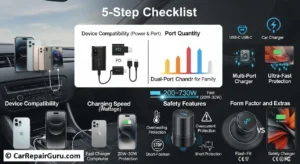
Now that you know the lingo and the options, it’s time to make a decision. Choosing the best car charger doesn’t have to be complicated. Just walk through this simple checklist to find the one that’s perfectly tailored to your needs.
1. Check Your Device’s Needs (Power & Port)
The most powerful charger in the world won’t do you any good if it’s not compatible with your device. Start by looking at what you’ll be plugging in.
- For newer iPhones (12 and up), Google Pixels, and Samsung Galaxy phones: You need a USB-C car charger with Power Delivery (PD) to get the fastest speeds. Don’t settle for less.
- For older smartphones or accessories (like headphones): A standard USB-A port will work just fine.
- For tablets like an iPad Pro or a laptop like a MacBook Air: Look for a high-wattage USB-C PD charger, specifically one that offers 30W or more from a single port.
2. Count Your Devices (Port Quantity)
Think about a typical drive. Are you usually alone, or is your car the mobile command center for your family?
- Solo Commuter: A single, powerful USB-C port might be all you need for a clean, minimalist setup. A sleek flush fit car charger would be a great choice.
- Driving with a Partner: A dual-port charger (ideally one USB-C and one USB-A) offers flexibility for both of you.
- Family Road Trips: A car charger with multiple ports is a non-negotiable lifesaver. Look for options with three or four ports to prevent arguments over who gets to charge their device next.
3. Prioritize Charging Speed (Wattage)
Don’t let a slow charger ruin your day. For modern devices, wattage is king. Here’s a simple guide to how many watts for a car charger you should look for:
- Good (Basic Charging): 12W. This is a step up from old 5W chargers but won’t be considered “fast.”
- Better (Fast Charging): 20W-30W. This is the sweet spot for quickly charging any modern smartphone. A 20W PD charger can typically boost an iPhone’s battery by 50% in about 30 minutes.
- Best (Ultra-Fast/Multi-Device Charging): 45W+. These powerful chargers can fast-charge a phone and a tablet simultaneously or even power a small laptop.
4. Don’t Forget Safety Features
This is a big one. A car’s electrical system can have fluctuations, and you want a charger that protects your expensive smartphone from them. Reputable brands like Anker car charger or Belkin build in crucial safety features. Never buy a charger that doesn’t advertise:
- Overheating Protection: Shuts down if it gets too hot.
- Overcurrent Protection: Prevents too much power from being drawn.
- Short-Circuit Protection: Protects against electrical faults.
Look for safety certifications like UL, CE, or FCC on the packaging. These indicate the product has been independently tested to meet strict safety standards.
5. Consider Form Factor and Extras
Finally, think about the little details that improve the day-to-day experience.
- Size: Do you want a flush fit car charger that disappears into your console, or a larger one that’s easier to grab?
- LED Indicator: A small light is helpful to confirm it’s receiving power, but make sure it’s not so bright that it becomes a distraction while driving at night.
- Materials: A metal casing will feel more premium and dissipate heat better than cheap plastic.
Our Top Picks: The Best Car Chargers of 2025
After countless hours of research and testing, we’ve rounded up the best options on the market. These selections balance speed, safety, features, and value to give you the best possible charging experience on the road.
(Note: Product availability and models change. These recommendations represent the best in each category at the time of writing.)
Best Overall Car Charger: [Example: Anker 521 Charger (40W)]
Why we chose it: This is the perfect do-it-all charger. With two powerful USB-C PD ports, it can fast-charge two phones simultaneously, delivering 20W to each. It’s compact, packed with Anker’s excellent safety features, and offers incredible performance for its price. It’s the one charger we’d recommend to almost anyone.
Best USB-C PD Fast Charger: [Example: Belkin BOOST↑CHARGE™ Dual USB-C Car Charger 40W]
Why we chose it: For those who crave maximum speed for a single device, this is a top contender. It delivers a massive burst of power from its primary USB-C port, making it ideal for quickly topping up a phone or even charging a tablet at full speed. It’s built like a tank and backed by a brand known for its reliability and safety.
Best Wireless Charging Mount (MagSafe/Qi): [Example: ESR HaloLock Car Charger with CryoBoost]
Why we chose it: This MagSafe car charger solves the biggest problem with wireless charging: heat. Its built-in cooling fan allows it to charge an iPhone at its maximum 15W speed without overheating and slowing down. The magnet is incredibly strong, the design is sleek, and the convenience is simply unmatched for iPhone 12 users and newer.
Best Budget Car Charger: [Example: UGREEN 20W USB C Car Charger]
Why we chose it: Proving you don’t have to spend a fortune to get a great charge, this little powerhouse offers 20W Power Delivery in an ultra-compact body for a rock-bottom price. It has all the essential safety certifications and is perfect for someone who just needs a simple, reliable, and fast car charger without any extra frills.
Best Multi-Port Charger for Families: [Example: AINOPE 6-Port Car Charger 72W]
Why we chose it: This is the ultimate solution for a tech-heavy family on a road trip. It often features a main unit for the front seats and an extension hub with multiple ports that can reach the back seats. With a mix of USB-C and USB-A ports, it can handle phones, tablets, Nintendo Switches, and more, ensuring everyone arrives at the destination fully charged and happy.
The Dangers of Cheap Chargers & How to Use Yours Safely
In the world of electronics, you often get what you pay for, and this is especially true for car chargers. That tempting $5 charger hanging by the gas station register might seem like a bargain, but it could end up costing you dearly in the long run. Investing a little more in a quality charger isn’t just about speed—it’s about safety.
Why You Should Avoid That Bargain-Bin Charger
That cheap, unbranded charger is inexpensive for a reason. It cuts corners on the things you can’t see but absolutely need: quality components and safety mechanisms. Here are the risks:
- Damage to Your Device: These chargers often provide “dirty” or unstable power. Inconsistent voltage and current can slowly degrade your phone’s battery health, leading to a shorter lifespan. In a worst-case scenario, a power surge from a poorly made charger could fry your device’s charging port or internal circuitry, leading to a costly repair.
- Overheating and Fire Risk: Without proper heat sinks and thermal management, cheap chargers can get dangerously hot. This not only poses a risk to your car’s interior but, in rare cases, can lead to melting, smoking, or even a fire.
- No Failsafes: A quality car charger has an intelligent chip that communicates with your device to deliver the optimal amount of power. It also includes protection against overcharging, short-circuiting, and voltage spikes. Cheap chargers lack this intelligence, creating a much higher risk of something going wrong.
Look for the Logo: Understanding Safety Certifications
When you’re shopping, keep an eye out for small logos on the packaging or the device itself. These aren’t just for decoration; they are proof that the charger has been independently tested and meets rigorous safety standards. The most important ones to look for are:
- UL Listed: This is the gold standard in North America. It means Underwriters Laboratories has tested the product for fire and electrical safety to ensure it won’t be a hazard.
- CE Marking: A requirement for products sold in Europe, this mark signifies that the charger meets EU standards for health, safety, and environmental protection.
- FCC Compliant: This certification from the U.S. Federal Communications Commission ensures the charger’s electronic emissions won’t interfere with other radio frequencies, like your car radio or GPS signal.
Best Practices for Car Charger Longevity and Safety
Even with a high-quality charger, a little care goes a long way.
- Plug it in Firmly: Make sure the charger is fully seated in the 12V socket to ensure a stable connection.
- Unplug When Not in Use: While the risk is low in modern cars, it’s good practice to unplug the charger when you turn the vehicle off to prevent any minor car battery drain.
- Manage Your Cables: Avoid sharply bending or yanking on your cables, which can damage both the cable and the charger’s port over time.
- Keep it Cool: On extremely hot days, avoid leaving your charger and phone baking in direct sunlight on the dashboard, as excessive heat is bad for all electronics.
Beyond the Charger: Choosing the Right Cables and Mounts
Your new high-speed fast car charger is the engine, but it’s not the only part of the system. To get the best performance, you also need to consider the components it connects to: your charging cable and phone mount. Pairing the right accessories with your charger will create a seamless, safe, and efficient in-car setup.
Why Your Charging Cable Matters Just as Much
Plugging a flimsy, low-quality cable into a powerful 30W PD charger is like trying to put out a fire with a drinking straw. It simply won’t work effectively. A cheap cable can’t handle the higher power, which will throttle your charging speeds and can even be a safety risk.
- For Apple Users (MFi Certified): Always look for cables that are “Made for iPhone/iPad” (MFi) certified. This means Apple has approved the cable to meet its strict standards for quality and safety, ensuring it will work flawlessly with your devices.
- For Android/USB-C Users (USB-IF Certified): Look for the USB-IF (USB Implementers Forum) certification. This ensures the cable is built to proper specifications to handle high-speed charging and data transfer safely.
- Durability and Length: Consider a braided nylon cable for enhanced durability against twists and turns. Choose a length that comfortably reaches from the socket to your mount without too much excess slack to get tangled.
Pairing Your Charger with the Perfect Phone Mount
Your charging setup should be convenient, not a distraction. The right mount keeps your phone secure and visible for navigation without requiring you to take your eyes off the road.
- For Wired Chargers: If you have a separate charger and cable, you have endless mount options: vent clips, dashboard suction cups, or windshield mounts. Choose one that places your phone in your natural line of sight.
- For Wireless Chargers: The ultimate convenience is a 2-in-1 wireless car charger mount. As mentioned earlier, a MagSafe car charger is the top choice for newer iPhone users due to its secure magnetic alignment. For other Qi-compatible phones, look for a mount with automatic clamping arms that grip your phone securely when it’s placed in the cradle.
Creating the Ultimate In-Car Charging Setup
The perfect system is one that works for you. Combine a powerful, certified multi-port car charger with a high-quality MFi or USB-IF certified cable and a sturdy, well-placed mount. This trio ensures your devices charge quickly, are protected from electrical risk, and are positioned safely for at-a-glance navigation.
Troubleshooting Common Car Charger Problems
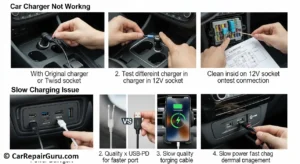
Even the best car charger can sometimes seem to act up. Before you assume it’s broken, run through this quick troubleshooting guide. Most issues are caused by a simple, fixable problem.
My Car Charger Isn’t Working at All. Now What?
Don’t panic. Follow this checklist to diagnose the issue:
- Check the Connection: The most common issue is a loose connection. Push the charger firmly into the 12V “cigarette lighter” socket. You might need to give it a little twist to make sure the contacts are touching.
- Test the Port: Is it the charger or the car? Try plugging in a different charger that you know works. If that doesn’t work either, the problem is likely your car’s socket.
- Inspect the Fuse: The 12V accessory socket in your car is protected by a fuse. If other devices also don’t work in that port, you may have a blown fuse. Check your car’s manual to locate the fuse box and replace the appropriate fuse.
- Clean the Socket: Over time, dust, crumbs, and other debris can accumulate inside the socket and prevent a good connection. With the car turned off, carefully use a non-metallic object (like a wooden toothpick) to clean it out.
“Why is My Phone Charging So Slowly in the Car?”
This is a frustratingly common problem. The culprit is almost always one of these:
- You’re Using the Wrong Port: If you have a multi-port charger, make sure you are plugged into the high-wattage USB-C PD port, not the older, slower USB-A port.
- Your Cable is the Bottleneck: As mentioned above, a cheap or damaged cable cannot support fast charging speeds. Try a different, high-quality cable.
- Your Phone is Hot: Smartphones will automatically slow down charging speed if they get too hot to protect the battery. If your phone has been sitting in the sun or running intensive apps like GPS and streaming music, it may charge slowly until it cools down.
- You’re Using the Car’s Built-in USB Port: The USB ports that come built into many cars are often designed for data transfer (like for Apple CarPlay/Android Auto) and provide very little power—sometimes as low as 2.5W. They are not meant for charging.
My Charger Keeps Disconnecting or Falling Out
If your charger feels wobbly or loses its connection over bumps, the issue is usually the physical fit. Some car sockets are slightly wider than others. Look for a charger with strong, springy side contacts that can create a more secure grip, or try a different brand that may have a slightly different shape.
Powering Your Journey the Right Way
As we’ve seen, choosing the best car charger is about more than just finding something that fits in the socket. It’s about understanding your needs, prioritizing speed and safety, and investing in a quality piece of technology that protects your valuable devices.
By now, you should feel confident in decoding terms like Power Delivery, knowing the difference between a simple USB-A plug and a powerful USB-C car charger, and recognizing the value of safety certifications. Whether you need a minimalist flush fit charger for your daily commute, a versatile multi-port charger for family adventures, or the cable-free convenience of a MagSafe car charger, there is a perfect solution waiting for you.
Don’t let a slow, unreliable charge add stress to your drive. Upgrade your setup, choose the right accessories, and enjoy the peace of mind that comes with knowing you have fast, dependable power whenever you need it.
Frequently Asked Questions (FAQ)
Will a car charger drain my car battery?
It is highly unlikely to drain your battery. Most modern cars cut power to the 12V outlet when the engine is off. For older cars with an “always-on” port, a quality charger draws such a tiny amount of power that it would take many weeks to affect a healthy battery.
What wattage car charger do I need for fast charging?
For fast charging modern smartphones, you need a car charger that provides at least 20 watts (20W). To charge a tablet or multiple devices simultaneously, a charger with 30W or more is even better. Anything below 18W will not deliver true fast-charging speeds.
Can a fast car charger damage my phone?
No, a quality fast charger will not damage your phone. Smart charging technologies like USB-C Power Delivery (PD) allow the charger and phone to communicate, ensuring your device only receives the fastest, safest amount of power it can handle, which prevents damage.
Is a wired or wireless car charger better?
A wired car charger is always faster and more efficient for pure charging speed. A wireless car charger offers superior convenience by eliminating cables and often doubling as a phone mount for navigation, making it a great choice for tidiness and ease of use.
What is the most important feature to look for in a car charger?
Safety certifications (like UL, CE, or FCC) are the single most important feature. These logos prove the charger has been independently tested to protect against overheating, overcharging, and short-circuiting. This is crucial for protecting both your phone and your vehicle.
